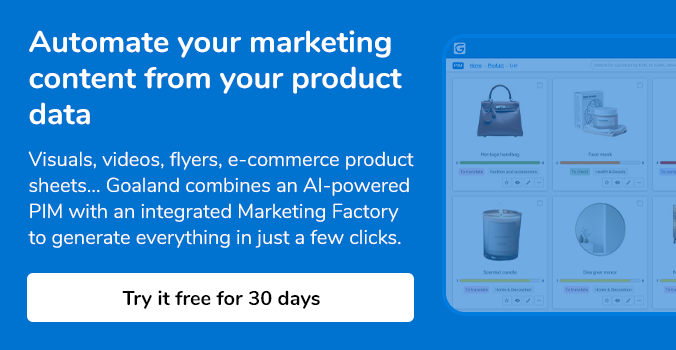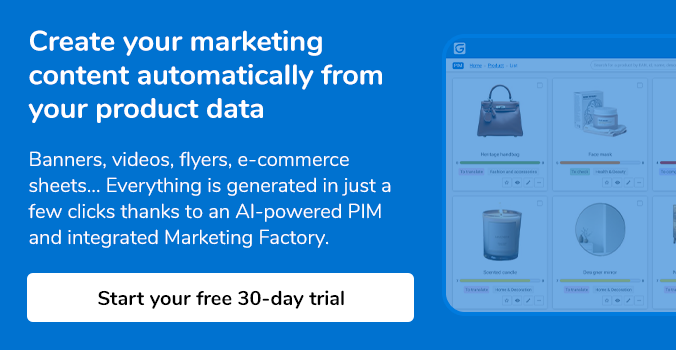Faced with the multiplication of sales channels, product information management software, known as PIM, now plays an essential role in the deployment of any omnichannel strategy. Centralizing product information, accelerating time to market, optimizing the customer experience, while PIM makes many promises, you need to choose a PIM perfectly suited to your company strategy. On the market of PIMs, two license models coexist: Proprietary PIM and PIM open source!
A lot of us tend to confuse open source with free of charge. It's time to clear up some of the preconceptions about this model. Whatever its cost, a PIM is not an expense, but an investment to enable you to efficiently manage the company's product information.
For this solution to be a veritable ally for the company's product strategy, it's best to make an informed decision and to compare the different PIM solutions available on the market in great detail. What really lies behind the expression “open source”? What makes Proprietary PIM different to PIM open source? In this dynamic and constantly evolving market, you need to be aware of the notions and concepts that are mandatory for choosing a PIM aligned to your needs.
#PIM open source is not free
According to the survey carried out by PAC consulting firm and the researchers of IAE Valenciennes and Lyon, 82% of businesses see open source as a means of pooling and reducing development costs1. These figures show the persistence of the idea that open source is free. Even today, many companies still believe that a PIM open source is “a free of charge PIM”. A myth which is shattered by the reality of the market.

PIM software is not as easy to set up as word processing software. It's a complex solution requiring many different operations: installation on a server or cloud infrastructure, configuration (determining data models, retrieving existing elements, organization of the different user rights and profiles…), training for the different user profiles, integration (interactions with the information system, positioning of connectors, definition of the import or export process), support (change management, work groups, technical discussions, project management…) or specific development requirements. Once the project has begun, it also needs to be hosted, operated (on a dedicated infrastructure or as part of a cloud offer), support and upgrading to new versions.
To implement these different actions properly, PIM publishers provide different organization models and varied economic principals.
So, while open source publishers promote “free” versions, these versions don't include any of the services mentioned above. In the best-case scenario, they are available as options, but more often than not, you need to buy a paying version to access certain services such as professional support or functions essential to your company. Like any other business, software publishers have to maintain the economic viability of their activity2: so whatever is not billed as a “license” will be billed as a “service”, and the “free” version is often no more than a bait luring you towards the paying version.
To compare the costs of the different solutions, we advise you to analyze all the elements and to compare solutions which provide the functional scope and the level of service required by the company.So, if it's not the global cost of the solution that differentiates the two models, what is really the difference between PIM open source and Proprietary PIM?
#PIM open source vs Proprietary PIM, what's the difference?
The difference between the open source and proprietary models is the access to the source code. In the open source model, the software license generally allows access to use, study and modify the source code. While the principal of this open source model is attractive, what is the real advantage for a business?
According to a survey carried out among 117 organizations is France3, the key motivations for choosing the open source model are customization and technological independence, a fact which is illustrated widely in the professional world. By choosing an PIM open source, businesses express a desire to customize and personalize the PIM according to their needs. In this case, it's the business itself or its integrator that modify and enhance the code to make their specific developments (customizations, integrations…). And this is where the problem lies!

According to this same survey1, one of the top three reasons for not choosing an open source solution is the lack of technical and legal expertise. Very few companies have the necessary technical resources available to develop their “tailor-made” PIM. Therefore, companies are usually dependent on a partner integrator as well as depending on the PIM publisher. And the impacts of this situation are even more important when the time comes for upgrading.
When a new version is designed, the publisher is not aware of all the developments made by their clients or their integrators, which is why they cannot guarantee compatibility with their new developments. So, any parallel developments made by the company or by their integrator will automatically create difficulties when it comes to migrating to the new version of the software. To avail of the tool's new functions and maintain the existing structure, for each new version, the company or their integrator must check and adapt all the developments implemented previously.
With a Proprietary PIM, only the editor customizes the solution to meet the specific requirements of their client. The publisher is therefore aware of all the developments that they have implemented previously and can guarantee their compatibility with the new versions. Moreover, it often happens that the publisher, in response to a specific client use case, will add one or more modules to the core version and that all their clients can benefit from these new functions. The publisher is also in charge of the maintenance of the customer's developments and the successive upgrades to their solution.
To combat these upgrading related problems, the latest recommendations are to implement, whenever possible, API (Application Programming Interface) based architecture. They define standardized and controlled interfaces allowing for improvement and command of the applications without accessing the source code. For the company looking for both a PIM and a solution to their customization requirements, it is far more important to know if the product that they wish to use has an API than free access to its source code. Finally, it is of course essential to look very closely at the functionalities provided by this API to ensure that they allow you to carry out the tasks required.
Today, companies tend to prefer the Proprietary model. This is why we deliberately chose this option for the development of the Goaland solution. By maintaining control over our source code, we wish to provide our clients with the full benefit of the developments to the solution. This is why we integrate a maximum of specific developments into the core of the solution which allows us to continually develop the Goaland PIM functionalities in addition to our own roadmap. The Goaland PIM solution is also available in cloud version.
1Fouquet,C.(2017, 12).Etude sur l'impact du logiciel libre / Open Source en France en 2017-2021. syntec-numerique.fr.
2
Gros, M. (2019, 12). Recap 2019 open source : Trouver le bon modèle économique reste difficile.lemondeinformatique.fr
3
Beky, A. (2019, 12). Open Source : la France a une longueur d'avance sur ses voisins. silicon.fr







